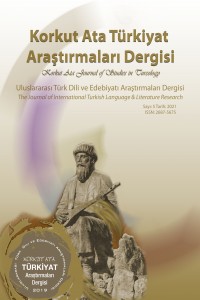Abstract
Halide Edib Adıvar, eserleriyle Türk Kurtuluş Savaşı’nın kazanılmasına katkıda bulunmuş bir yazardır. Bu çalışmada, en ünlü eserlerinden olan Ateşten Gömlek adlı romanında yapmış olduğu “biz” ve “ötekiler” tasvirleri irdelenmektedir. “Biz ve ötekiler” teorisi Edward Said tarafından oryantalistler için kullanılan, Batılıların Doğululara karşı olumsuz düşüncelerini açıklayan bir teoridir. Said’in teorisinden çok önce yazılan Ateşten Gömlek’te ise, bu teori, romanda yer alan kanonik söylem doğrultusunda farklı şekilde karşımıza çıkmaktadır. Romanda, hürriyet yanlısı Türkler “biz”, Türklere ihanet etmiş şekilde yansıtılan Osmanlı yönetimi ve Türk düşmanları “ötekiler” olarak tasvir edilmektedir. Romanda, Türk milleti yüce, cesur, gözü pek ve korkusuz bir millet olarak nitelendirilmektedir. Osmanlı Devleti’nde yaşayan ve Türklere karşı işgal kuvvetlerinin yanında duran Rum ve Ermeni gibi azınlıklar da işkenceler yapan katiller olarak tasvir edilmesinden dolayı, “ötekiler”dendir. Osmanlı yönetimi de “ötekiler” grubuna girmektedir. Çünkü onlar da işgalcilerle iş birliği yapmakta, Türk milletine ihanet etmektedirler. Bu çalışmada doküman analizi yöntemi kullanılarak, Edward Said’in “biz ve ötekiler” teorisinin, Halide Edib Adıvar tarafından Ateşten Gömlek romanında Türkler için uyarlanması, romandaki örnekler baz alınarak irdelenmektedir.
References
- Adıvar, Halide Edib (2014). Ateşten Gömlek (e-kitap). İstanbul: Can Yayınları.
- Atakay, Kemal (2004). Kanon Huzursuzluğu. Kitap-lık, 68, 70-77.
- Babayeva, Eşgane (2016). Kurtuluş Savaşının ve Ateşten Gömlek Romanındaki Doğu-Batının Türk Romanına Olan Etkisi. Hikmet, 28, 55-63.
- Çıkla, Selçuk (2007). Türk Edebiyatında Kanon ve İnkılâp Kanonu. Muhafazakar Düşünce, 4(13-14), 25-46.
- Çoruk, Ali (2007). Oryantalizmin Sergüzeşt’i. İstanbul Üniversitesi Edebiyat Fakültesi Türk Dili ve Edebiyatı Dergisi, 36(36), 79-100.
- Eskin, Mehmet Şerif (2017). Cumhuriyet Türkiyesi’nde (1923-1950) Ulusal Kimlik ve Hafıza İnşası Bağlamında Edebiyat Faaliyetleri. Yayımlanmamış Doktora Tezi. İstanbul: İstanbul Üniversitesi.
- Güneş, Ali (2007). Edebiyat ve Toplum. Muhafazakâr Düşünce, 4(13- 14), 69- 94.
- Köroğlu, Erol (2004). Türk Edebiyatı ve Birinci Dünya Savaşı (1914-1918): Propagandadan Millî Kimlik İnşâsına. İstanbul: İletişim Yayınları.
- Kösemihal, Nurettin Şazi (1967). Edebiyat Sosyolojisine Giriş. Sosyoloji Dergisi, 2(19-20), 1-37.
- Özbolat, Abdullah (2012). Bir Ulus Yaratmak: Erken Dönem Cumhuriyet Romanında Din Adamının Temsili. Turkish Studies, 7(4), 2473-2483.
- Parla, Jale (2004). Edebiyat Kanonları. Kitap-lık, 68 (2004), 51-53.
- Said, Edward (2003). Orientalism. London: Penguin Books.
- Türkeş, Ömer (2001). Güdük Bir Edebiyat Kanonu. Modern Türkiye’de Siyasi Düşünce 2-Kemalizm. İstanbul: İletişim Yayınları, 425-429.
Abstract
Halide Edib Adıvar is an author who contributed to the Turkish Independence War with her literary works. In this study, the depictions of “we” and “others” that she made in her novel, The Shirt of Flame, which is one of her most famous novels, are examined. The “self and others” theory is a theory used by Edward Said for orientalists to explain the negative thoughts of Westerners towards Easterners. In The Shirt of Flame, which was written long before Said’s theory, the theory appears in a different way in line with the canonical discourse. In the novel, the pro-freedom Turks are described as “we”, the Ottoman administration that betrayed the Turks, and the enemies of Turks as “others”. The Turkish nation is described as a great, brave, courageous, and fearless nation in the novel. Minorities such as Greeks and Armenians, who lived in the Ottoman Empire and stood by the invaders against the Turks, are among the “others” because they are portrayed as torturers and murderers. The Ottoman administration is also in the group of “others” because they also cooperate with the enemies of Turks and betray the Turkish nation. In this study, the adaptation of Edward Said’s “self and others” theory by Halide Edib Adıvar for Turks in the novel, The Shirt of Flame is analysed based on the examples in the novel, using the document analysis method.
Keywords
Halide Edib Adıvar The Shirt of Flame canonical discourse orientalism “self and others” theory.
References
- Adıvar, Halide Edib (2014). Ateşten Gömlek (e-kitap). İstanbul: Can Yayınları.
- Atakay, Kemal (2004). Kanon Huzursuzluğu. Kitap-lık, 68, 70-77.
- Babayeva, Eşgane (2016). Kurtuluş Savaşının ve Ateşten Gömlek Romanındaki Doğu-Batının Türk Romanına Olan Etkisi. Hikmet, 28, 55-63.
- Çıkla, Selçuk (2007). Türk Edebiyatında Kanon ve İnkılâp Kanonu. Muhafazakar Düşünce, 4(13-14), 25-46.
- Çoruk, Ali (2007). Oryantalizmin Sergüzeşt’i. İstanbul Üniversitesi Edebiyat Fakültesi Türk Dili ve Edebiyatı Dergisi, 36(36), 79-100.
- Eskin, Mehmet Şerif (2017). Cumhuriyet Türkiyesi’nde (1923-1950) Ulusal Kimlik ve Hafıza İnşası Bağlamında Edebiyat Faaliyetleri. Yayımlanmamış Doktora Tezi. İstanbul: İstanbul Üniversitesi.
- Güneş, Ali (2007). Edebiyat ve Toplum. Muhafazakâr Düşünce, 4(13- 14), 69- 94.
- Köroğlu, Erol (2004). Türk Edebiyatı ve Birinci Dünya Savaşı (1914-1918): Propagandadan Millî Kimlik İnşâsına. İstanbul: İletişim Yayınları.
- Kösemihal, Nurettin Şazi (1967). Edebiyat Sosyolojisine Giriş. Sosyoloji Dergisi, 2(19-20), 1-37.
- Özbolat, Abdullah (2012). Bir Ulus Yaratmak: Erken Dönem Cumhuriyet Romanında Din Adamının Temsili. Turkish Studies, 7(4), 2473-2483.
- Parla, Jale (2004). Edebiyat Kanonları. Kitap-lık, 68 (2004), 51-53.
- Said, Edward (2003). Orientalism. London: Penguin Books.
- Türkeş, Ömer (2001). Güdük Bir Edebiyat Kanonu. Modern Türkiye’de Siyasi Düşünce 2-Kemalizm. İstanbul: İletişim Yayınları, 425-429.
Details
| Primary Language | Turkish |
|---|---|
| Subjects | Creative Arts and Writing |
| Journal Section | Araştırma Makaleleri |
| Authors | |
| Publication Date | August 31, 2021 |
| Submission Date | July 30, 2021 |
| Published in Issue | Year 2021 Issue: 5 |

